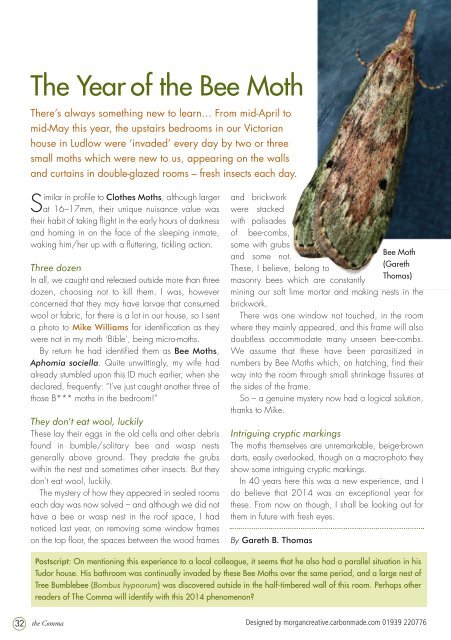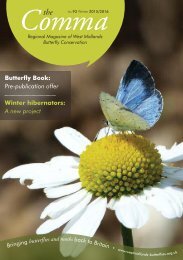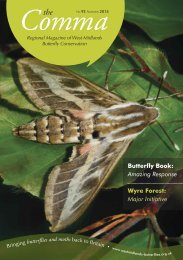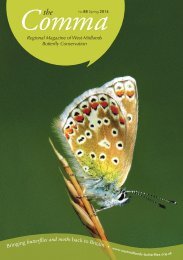Comma-WestMidBC-autumn-2014
Butterfly Magazine for the West Midlands Branch of Butterfly Conservation
Butterfly Magazine for the West Midlands Branch of Butterfly Conservation
You also want an ePaper? Increase the reach of your titles
YUMPU automatically turns print PDFs into web optimized ePapers that Google loves.
The Year of the Bee Moth<br />
There’s always something new to learn… From mid-April to<br />
mid-May this year, the upstairs bedrooms in our Victorian<br />
house in Ludlow were ‘invaded’ every day by two or three<br />
small moths which were new to us, appearing on the walls<br />
and curtains in double-glazed rooms – fresh insects each day.<br />
Similar in profile to Clothes Moths, although larger<br />
at 16–17mm, their unique nuisance value was<br />
their habit of taking flight in the early hours of darkness<br />
and homing in on the face of the sleeping inmate,<br />
waking him/her up with a fluttering, tickling action.<br />
Three dozen<br />
In all, we caught and released outside more than three<br />
dozen, choosing not to kill them. I was, however<br />
concerned that they may have larvae that consumed<br />
wool or fabric, for there is a lot in our house, so I sent<br />
a photo to Mike Williams for identification as they<br />
were not in my moth ‘Bible’, being micro-moths.<br />
By return he had identified them as Bee Moths,<br />
Aphomia sociella. Quite unwittingly, my wife had<br />
already stumbled upon this ID much earlier, when she<br />
declared, frequently: “I’ve just caught another three of<br />
those B*** moths in the bedroom!”<br />
They don’t eat wool, luckily<br />
These lay their eggs in the old cells and other debris<br />
found in bumble/solitary bee and wasp nests<br />
generally above ground. They predate the grubs<br />
within the nest and sometimes other insects. But they<br />
don’t eat wool, luckily.<br />
The mystery of how they appeared in sealed rooms<br />
each day was now solved – and although we did not<br />
have a bee or wasp nest in the roof space, I had<br />
noticed last year, on removing some window frames<br />
on the top floor, the spaces between the wood frames<br />
and brickwork<br />
were stacked<br />
with palisades<br />
of bee-combs,<br />
some with grubs<br />
Bee Moth<br />
and some not.<br />
(Gareth<br />
These, I believe, belong to<br />
Thomas)<br />
masonry bees which are constantly<br />
mining our soft lime mortar and making nests in the<br />
brickwork.<br />
There was one window not touched, in the room<br />
where they mainly appeared, and this frame will also<br />
doubtless accommodate many unseen bee-combs.<br />
We assume that these have been parasitized in<br />
numbers by Bee Moths which, on hatching, find their<br />
way into the room through small shrinkage fissures at<br />
the sides of the frame.<br />
So – a genuine mystery now had a logical solution,<br />
thanks to Mike.<br />
Intriguing cryptic markings<br />
The moths themselves are unremarkable, beige-brown<br />
darts, easily overlooked, though on a macro-photo they<br />
show some intriguing cryptic markings.<br />
In 40 years here this was a new experience, and I<br />
do believe that <strong>2014</strong> was an exceptional year for<br />
these. From now on though, I shall be looking out for<br />
them in future with fresh eyes.<br />
By Gareth B. Thomas<br />
Postscript: On mentioning this experience to a local colleague, it seems that he also had a parallel situation in his<br />
Tudor house. His bathroom was continually invaded by these Bee Moths over the same period, and a large nest of<br />
Tree Bumblebee (Bombus hypnorum) was discovered outside in the half-timbered wall of this room. Perhaps other<br />
readers of The <strong>Comma</strong> will identify with this <strong>2014</strong> phenomenon?<br />
32<br />
the <strong>Comma</strong><br />
Designed by morgancreative.carbonmade.com 01939 220776









